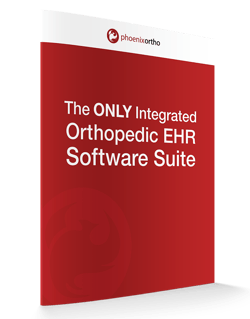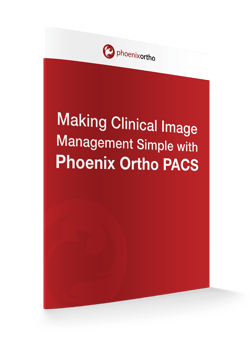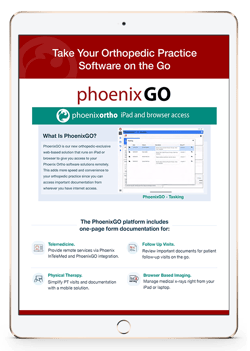Medical images are essential to your orthopedic practice; after all, x-rays and other internal images are crucial for spotting musculoskeletal system issues that you can diagnose and treat. The way you manage medical images, however, can make or break the efficiency of your practice.
For example, it can feel tedious and frustrating to store your patient information in one software program but use third-party software to view diagnostic imaging. Imagine how much time and energy you could save by implementing a streamlined, all-in-one medical image management software!
The current state of your practice’s image management strategy can help or hinder your approach to patient care. After all, spending hours organizing hundreds of patient images every day leaves less time for you to focus on delivering quality care and adds to the overall stress you go through.
While EHRs can typically provide links to picture archiving and communication systems (PACS), Phoenix Ortho is the only orthopedically-focused EHR with a full PACS built-in. The images you need to provide the high level of care you desire are literally contained in the patient record for fast and simple access.
Such a system could greatly improve your medical image management and save you—and your staff—precious time so that you can all focus on something more important: treating your patients.
Keep reading to learn more about medical image management and how an effective system can save you time and energy!
Common Medical Image Management Challenges
When it comes to medical image management, there are a few recurring challenges that orthopedic practices encounter, including:
1. Disconnected Software to Access and Organize Images
Taking hundreds of images each day is moot if you’re not able to easily access or organize them according to each patient. When you’re working with multiple software programs from different vendors to accomplish the task of accessing and categorizing images, you’re spending precious time clicking numerous buttons instead of simply working within a streamlined system.
If your current medical image management workflow doesn’t enable your clinic to effectively handle, sort, print, or transmit images, then it’s time to consider a comprehensive system that lessens your workload instead of adding to it.
2. Risk of Losing Important Patient Information
For some systems, it’s a challenge to reclassify or transmit images for fear of losing important patient information along the way. Key points of data, such as the patient’s name, address, type of exam, date of exam, etc. are crucial for providing a comprehensive understanding of the medical images.
Without this information, it’s impossible to accurately or efficiently categorize patient images which can lead to fallout in the medical images management workflow. Also, when clinical image management software isn’t integrated into the same platform as your patient data management tools, there’s a greater risk of data being lost or filed under the wrong patient record.
Having an integrated PACS solution that works with your Electronic Health Record (EHR) system is crucial for maintaining efficient control over patient images and data.
3. Overwhelmed and Stressed Staff
Chances are that you and your orthopedic practice staff are incredibly busy since orthopedic surgeons rank among the busiest types of medical specialists in healthcare. There’s an overwhelming workload being distributed among all the staff at your practice. Adding a clunky, outdated picture archiving and communication software system simply doesn’t do anything to help your practice manage its workload more effectively.
This can be made even more extreme by manually-entered information that goes into your database, such as that entered during X-rays, ultrasounds, or other imaging. For every manually-entered piece of information, there’s also the chance that it gets entered incorrectly as a typo — something that Phoenix Ortho fixes by electronically completing that information to eliminate the risk of accidental manual entry.
Types of Medical Images Used in Orthopedics
In your orthopedic practice, you and your colleagues are likely working with various types of medical images relating to the diagnosis and treatment of your patients, such as:
Magnetic Resonance Imaging (MRI)
MRI is a non-invasive and painless procedure that utilizes a large magnetic field and radio waves to create images of different organs and structures within the body. An advanced computer system is able to translate the magnetic field and radio waves into detailed, intricate medical images that providers can study for further understanding of the patient’s status.
This type of medical imaging can detect numerous diseases and abnormalities such as tumors or joint issues in soft tissues like tendons, ligaments, and muscles, in addition to capturing images of the musculoskeletal system. MRI can be applied to nearly any part of the patient, including large portions of the body, and roughly take up to an hour from start to finish, depending on the complexity of the scan and how many medical images are needed.
Computed Tomography (CT) Scan
A computed tomography scan utilizes x-rays to produce cross-sectional scans of the body part being scanned. A CT scan differs from an MRI procedure in that they use different frequencies of x-rays to produce the medical images. Both scans are similar in that they are non-invasive and painless.
You might arrange for a patient to undergo a CT scan in order to locate and analyze bone fractures or other musculoskeletal disorders affecting your orthopedic patient.
Sometimes a special dye called “contrast material” is incorporated into the CT scan process; this material appears white on the scans and is able to block x-rays so that blood vessels or other internal structures appear more prominently–which may be useful for identifying blood clots or other conditions that can affect muscular health.
Radiography (X-Ray) Imaging
X-ray imaging has been a valuable tool in the medical field for many decades. It’s a non-invasive, painless procedure that can diagnose and help orthopedic surgeons evaluate broken bones, misaligned vertebrae, and other skeletal system disorders. It works by passing small, controlled amounts of radiation through the human body in order to capture shadows and reflections on a photographic plate.
In today’s orthopedic field, x-ray imaging is digital instead of relying on film; this helps minimize the amount of radiation needed and enables providers to enhance images on the computer.
Ultrasound Imaging
As with all other types of medical imaging listed here, ultrasound is a non-invasive and painless procedure that is safe for all patients, including pregnant patients, children, and people with pacemakers or other metal implants.
Ultrasound involves using a handheld device that sends high-frequency sound waves into the body in order to provide a “moving” image of internal tissues, bones, and organs. This type of imaging helps to guide pain management injections, for example, which enables orthopedic providers to deliver medication accurately.
Musculoskeletal ultrasound imaging is an important tool for orthopedic practices since it can help diagnose and analyze tendon and ligament issues that might only primarily occur when moving. This type of medical imaging can also detect micro-tears that a larger imaging process, like MRI, might overlook. Ultrasound can be utilized to diagnose and evaluate many soft tissue injuries, including sprains, tendonitis, inflammation, hernias, and more.
Improving Your Medical Imaging Workflow with the Right PACS from Phoenix Ortho!
With an efficient and streamlined PACS that integrates into your orthopedic-specific EHR system from Phoenix Ortho, you’ll immediately gain more time and energy in your day with these advantages:
- Speedy Image Retrieval: With software that manages your PACS needs and your EHR organization style, you won’t be sitting around waiting for images to load or having to download them onto an external hard drive
- Integration with EHR system: A key component of a successful orthopedic practice is being able to deliver quality care and collaborate with other specialists when treating a patient from a holistic perspective; when you have images and patient information in one place, you can make great strides in these efforts
- Only Learn One, User-Friendly Software: Neither you nor your colleagues have time to spend hours learning multiple types of software and how they are supposed to work together to accomplish the same goal; with Phoenix Ortho’s integrated PACS and EHR system, specifically designed for orthopedic practices, you can quickly manage everything within one software
Ready to optimize your orthopedic practice’s medical image management workflows? Speak to a PACS specialist from Phoenix Ortho today!
Schedule a 1:1
Get in touch with Phoenix Ortho to learn more about how you can save time, money, and mouse clicks with an orthopedic-specific EHR.





















